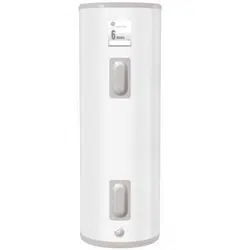Documents: Go to download!
User Manual
- Owner's manual - (English)
- Installation Instructions - (English)
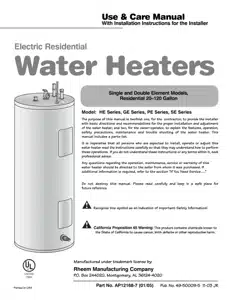
- Operating Instructions
- Care and cleaning
- Troubleshooting Tips
Table of contents
USER MANUAL SmartWater Electric Water Heater
Operating Instructions
Operating the water heater.
 CAUTION: Hydrogen gas can be produced in a hot water system served by this water heater that has not been used for a long period of time (generally two weeks or more). HYDROGEN GAS IS EXTREMELY FLAMMABLE!! To dissipate such gas and to reduce risk of injury, it is recommended that the hot water faucet be opened for several minutes at the kitchen sink before using any electrical appliance connected to the hot water system. If hydrogen is present, there will be an unusual sound such as air escaping through the pipe as the water begins to flow. Do not smoke or use an open flame near the faucet at the time it is open.
CAUTION: Hydrogen gas can be produced in a hot water system served by this water heater that has not been used for a long period of time (generally two weeks or more). HYDROGEN GAS IS EXTREMELY FLAMMABLE!! To dissipate such gas and to reduce risk of injury, it is recommended that the hot water faucet be opened for several minutes at the kitchen sink before using any electrical appliance connected to the hot water system. If hydrogen is present, there will be an unusual sound such as air escaping through the pipe as the water begins to flow. Do not smoke or use an open flame near the faucet at the time it is open.
Safety Precautions
A. Do turn off power to water heater if it has been subjected to over heating, fire, flood, physical damage.
B. Do Not turn on water heater unless it is filled with water.
C. Do Not turn on water heater if cold water supply shut-off valve is closed.
D. If there is any difficulty in understanding or following the Operating Instructions or the Care and Cleaning section, it is recommended that a qualified person or serviceman perform the work.
 CAUTION: The cause of the high temperature condition must be investigated by qualified service technician and corrective action must be taken before placing the water heater in service again
CAUTION: The cause of the high temperature condition must be investigated by qualified service technician and corrective action must be taken before placing the water heater in service again
Safety Controls
The water heater is equipped with a combination thermostat and temperature limiting control (ECO) that is located above the heating element in contact with the tank surface. If for any reason the water temperature becomes excessively high, the temperature limiting control (ECO) breaks the power circuit to the heating element. Once the control opens, it must be reset manually
To reset the temperature limiting control:
- Turn off the power to the water heater.
- Remove the jacket access panel(s) and insulation. The thermostat protective cover should not be removed.
- Press the red RESET button.
- Replace the insulation and jacket access panel(s) before turning on the power to the water heater.
Water Temperature Setting
The temperature of the water in the water heater can be regulated by setting the temperature dial of the adjustable surface mounted thermostat(s) located behind the jacket access panel(s).
Dual element heaters have two thermostats.
Safety and energy conservation are factors to be considered when selecting the water temperature setting of the water heater’s thermostat(s). The lower the temperature setting, the greater the savings in energy and operating costs.
To comply with safety regulations the thermostat(s) are factory set at 120°F or less where local codes require. This is the recommended starting point.
Water temperatures above 125°F can cause severe burns or death from scalding. Be sure to read and follow the warnings outlined in this manual and on the label located on the water heater near the gas control (thermostat).
Mixing valves are available for reducing point of use water temperature by mixing hot and cold water in branch water lines . Contact a licensed plumber or the local plumbing authority for further information.
The chart below may be used as a guide in determining the proper water temperature for your home.
Time/Temperature Relationship in Scalds

If adjustment is necessary…
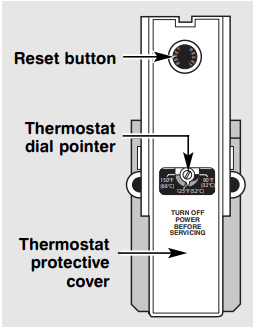 Type 59T thermostat and protective cover. | 1.Turn off the power to the water heater. 2. Remove the jacket access panel(s) and insulation exposing the thermostat(s). The thermostat protective cover(s) should not be removed. 3. Using a small screwdriver, set the thermostat(s) dial pointer(s) to the desired temperature. 4. Replace the insulation and jacket access panel(s). Turn on the power to the water heater. |
Care and cleaning
Draining the Water Heater
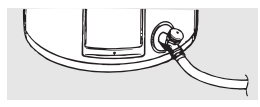 |
In order to drain the water heater, turn off the cold water supply. Open a hot water faucet or lift the handle on the relief valve to admit air to the tank. Attach a garden hose to the drain valve on the water heater and direct the stream of water to a drain. Open the valve. |
Vacation and Extended Shut-Down
NOTICE: Refer to the Hydrogen Gas Caution in the Operating Instructions.
If the water heater is to remain idle for an extended period of time, the power and water to the appliance should be turned off to conserve energy and prevent a build-up of dangerous hydrogen gas.
The water heater and piping should be drained if they might be subjected to freezing temperatures.
After a long shut-down period, the water heater’s operation and controls should be checked by qualified service personnel. Make certain the water heater is completely filled again before placing it in operation.
Routine Preventative Maintenance
Properly maintained, your water heater will provide years of dependable troublefree service.
It is suggested that a routine preventive maintenance program be established and followed by the user.
It is further recommended that a periodic inspection of the operating controls, heating element and wiring should be made by service personnel qualified in electric appliance repair.
Most electrical appliances, even when new, make some sound when in operation. If the hissing or singing sound level increases excessively, the electric heating element may require cleaning. Contact a qualified installer or plumbing contract to inspect.
At least once a year, lift and release the lever handle on the temperature pressure relief valve, located near the top of the water heater, to make certain the valve operates freely. Allow several gallons to flush through the discharge line to an open drain.
A water heater’s tank can act as a settling basin for solids suspended in the water. It is therefore not uncommon for hard water deposits to accumulate in the bottom of the tank. It is suggested that a few quarts of water be drained from the water heater’s tank every month to clean the tank of these deposits.
Rapid closing of faucets or solenoid valves in automatic water using appliances can cause a banging noise heard in a water pipe. Strategically located risers in the water pipe system or water hammer arresting devices can be used to minimize the problem.
The anode rod should be removed from the water heater’s tank annually for inspection and replaced when more than 6″ of core wire is exposed at either end of the rod.
Make sure the cold water supply is turned off before removing anode rod.
NOTICE: Do not remove the anode rod from the water heater’s tank, except for inspection and/or replacement, as operation with the anode rod removed will shorten the life of the glass lined tank and will exclude warranty coverage.
Troubleshooting Tips
| Possible Causes | What To Do | |
| Rumbling noise | Water conditions in your home caused a build up of scale or mineral deposits on the heating elements. | ● Remove and clean the heating elements. |
| Relief valve producing popping noise or draining | Pressure build up caused by thermal expansion to a closed system. | ● This is an unacceptable condition and must be corrected. Contact the water supplier or plumbing contractor on how to correct this. Do not plug the relief valve outlet. |
| Rattling noise during periods of water usage | Internal heat trap fittings in operation | ● This is normal for heat trap fittings when in operation and does not indicate a need for service. |
| Not enough or no hot water | Water usage may have exceeded the capacity of the water heater. | ● Wait for the water heater to recover after an abnormal demand |
| A fuse is blown or a circuit breaker tripped. | ● Replace fuse or reset circuit breaker. | |
| Electric supply may be off. | ● Make sure electric supply to water heater and disconnect switch, if used, are in the ON position. | |
| The thermostat may be set set too low. | ● See the Temperature regulation of the water heater section of this manual. | |
| Leaking or open hot water faucets. | ● Make sure all faucets are closed. | |
| Electric service to your home may be interrupted. | ● Contact the local electric utility. | |
| Improper wiring. | ● See the Installing the water heater section of this manual. | |
| Manual reset limit (ECO) | ● See the Temperature regulation of the water heater section of this manual. | |
| Cold water inlet temperature may be colder during the winter months. | ● This is normal. The colder inlet water takes longer to heat. | |
| Water is too hot | The thermostat is set too high. | ● See the Temperature regulation of the water heater section of this manual. |
CAUTION: For your safety DO NOT attempt repair of electrical wiring, thermostats, heating elements or other safety devices. Refer repairs to qualified service personnel.
Replacement Parts.
For 20–120 gallon models with single and double elements.
Instructions For Placing a Parts Order
To place orders using a Visa/MasterCard call 800-431-1549.
All parts orders should include:
- The model and serial number of the water heater from the rating plate.
- Specify voltage and wattage as marked on the rating plate.
- Part description (as noted below) and number of parts desired.
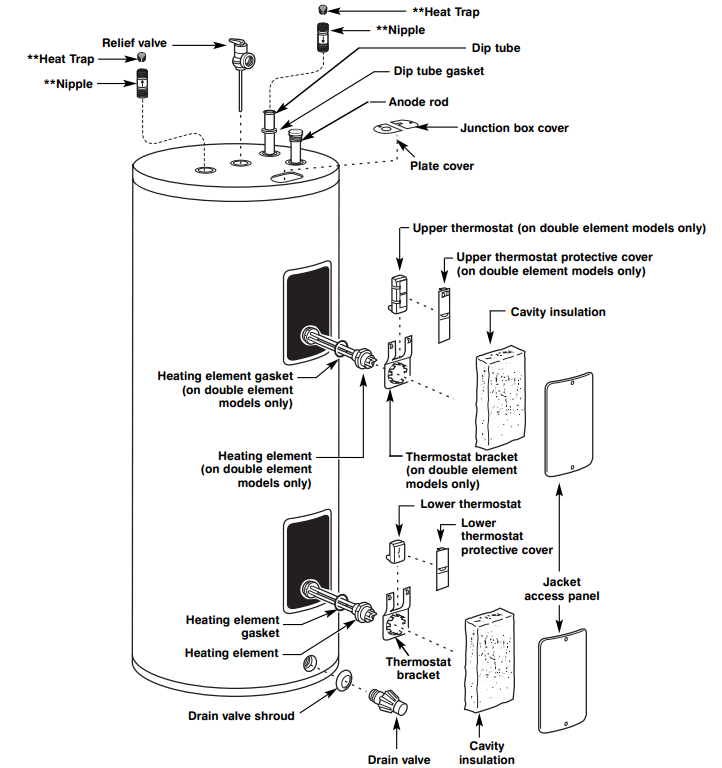
**Not supplied on all models
See other models: GE40M6A GE30T6MC00 GE30T6A GE30S6A GE30M6A
